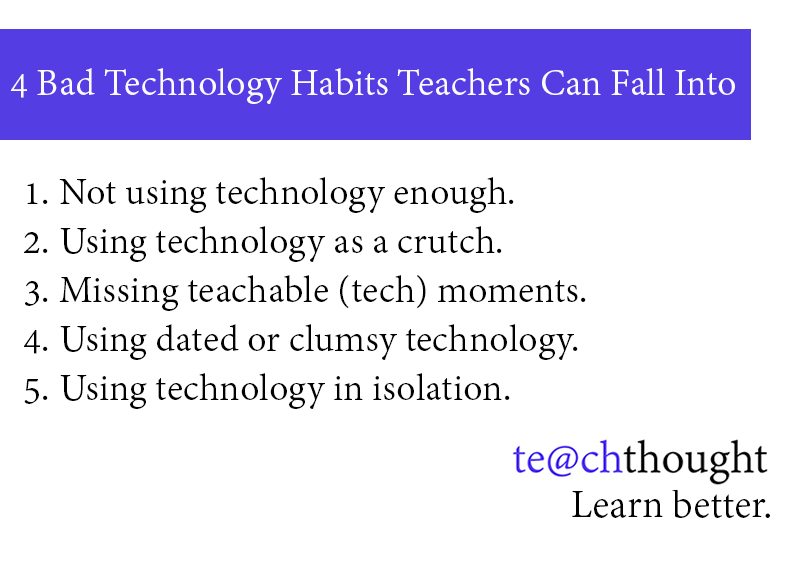
5 Bad Technology Habits Teachers Can Fall Into
by Aimee Hosler
Computer-based testing. Flipped classrooms. eLearning and online courses. Mobile learning. Personalized learning algorithms.
Technology has revolutionized learning — and teaching. It doesn’t always work as planned, but when it does, technology can promote student engagement, boost efficiency and help tomorrow’s workers develop the tech skills employers so desperately want. That is, of course, assuming teachers know how to use it. Here are a few bad tech habits many well-meaning teachers succumb to in the classroom (and how to avoid them).
5 Bad Technology Habits Teachers Can Fall Into
1. Not using technology enough.
Perhaps one of the biggest blunders teachers make is underusing technology in the classrooms, or, even worse, avoiding it altogether. They often mean well: In its 2013 study “Teen and Technology,” Pew Research notes that even from a young age, today’s students are decidedly plugged in, and some groups wonder how all that screen time affects a young person’s health and attention span. Many teachers choose to make the classroom a digital-free zone in an effort to minimize that screen time.
There is some credence to the argument that tech should be metered (more on that below), but, when used effectively, it can inspire and engage students in a way traditional lectures cannot. Using tools like Vine to present their work encourages students to think outside the box, and guided Internet research gives teachers an opportunity to teach Web safety and source discretion. Social media promotes collaboration and, according to a 2012 study from the University of Washington, may even help students reach certain social and developmental milestones.
The key is to recognize how — and when — technology is an effective teaching tool and not just another distraction.
2. Using technology as a crutch.
We have discussed many of the benefits of using technology in your classroom, but discretion counts. According to a 2012 joint-study from the College Board and the National Writing Project, almost all participating teachers agreed that the Internet expands students’ resources and helps them become more independent as researchers, but more than three-fourths also believe that search engines condition those students to expect to find information quickly and easily, undermining critical thinking skills. Another earlier study by the Kaiser Family Foundation suggested too much time spent online has “wired (students) for distraction.” The study revealed that 31 percent of students ages 8-18 were watching TV, using the Internet, or using other media “most” of the time while doing homework, while 25 percent of students were engaging in these activities “some” of the time.
In order for tech to work as a teaching tool, it must be used strategically. It must be metered, and assignments should be framed in a way that prioritizes learning, not just engagement.
3. Missing teachable (tech) moments.
Chances are students are more comfortable and familiar with today’s technologies than most of their teachers, but you should not necessarily take that for granted. There is a phenomenon that The Washington Post calls the “digital divide” in which some students — particularly those from poorer homes — do not have as much access to computers, devices and the Internet at home as their wealthier peers. Even students that know the ropes may not necessarily understand how to identify reputable Web-based sources, collaborate responsibly or limit personal risk online.
According to the College Board and NWF study noted above, fewer than 10 percent of teachers believed their students are “very good” or “excellent” at recognizing bias online. Many felt their students relied too heavily on a limited number of sources (namely Google and Wikipedia). Students need direction. As Tracy Gray, managing director with the American Institutes of Research, told USA Today, integrating technology into a classroom without teaching kids how to use it “just like bringing a piano into the classroom and expecting all of the students to become Chopin.”
4. Using dated or clumsy technology.
Most teachers or students have experienced a technical hiccup or two in the classroom. VCRs or DVD players may not always work properly, and projectors or digital whiteboards can fizzle out. Sometimes, however, these moments stem from teachers not taking the time to learn how to use technology before introducing it in the classroom. It’s not just embarrassing, but it also wastes valuable classroom time. It’s also very difficult to teach students how to use and get the most from technology — including devices and software — when you do not know them inside and out.
In other words, bust your own bad tech habits.
5. Using technology in isolation.
This isn’t always a bad thing, but in general technology should work together with the assessment which is tied to the curriculum which depends on data which is tied back to the technology.
Using #edtech in isolation not only limits its own effectiveness, but can reduce the entire ecology as one “area” takes away from another.
Aimee Hosler is a writer and mother of two living in Virginia. She specializes in a number of topics, but is particularly passionate about education and workplace news and trends. She hold a B.S. in Journalism from California Polytechnic State University in San Luis Obispo. She contributes to several websites, including OnlineSchools.com

